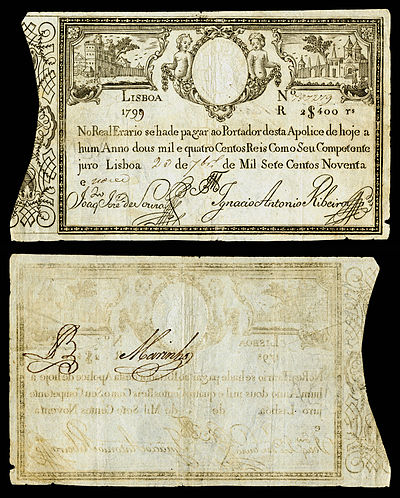Talk:Portuguese real
| Portugal Mid‑importance | ||||||||||||||
| ||||||||||||||
| Brazil Mid‑importance | |||||||
| |||||||
article is largely incomplete
There are large areas that need clarifying and others that need including:
1. Are the terms "real" and "reis" interchangeable? If so the article should be made consistent. If not, then there needs to be an explanation.2. There seems to be some kind of revaluation of the currency in 1826 that is only hinted at, but is not described or even outlined. Is this Gold, silver and copper values fluctuating? Something else.3. The decimalisation event is mentioned numerous times but is not described once. What changed at this time? Did it change the currency unit names? How did it change how much each unit was worth with respect to other units?
From the above, there seems to be large gaps in the description of the denominations and their nomenclature. There doesn't necessarily need o be a comprehensive list of all the coin issues, but a description of the currency units, how much they were worth in reales and the materials they were made from along with any changes in these would be sufficient in giving the reader a satisfactory picture of the Portuguese Real's history. — Preceding unsigned comment added by 80.176.89.230 (talk) 14:06, 18 November 2013 (UTC)
Undocumented character in IPA guide
The IPA pronunciation guide for Real is [ʁɨˈaɫ]. However, the linked Help:IPA for Portuguese doesn't document "ɫ". — Preceding unsigned comment added by Salty-horse (talk • contribs) 12:27, 27 September 2016 (UTC)
File:POR-4-Imperial Treasury-2400 Reis (1798-99).jpg to appear as POTD soon
Hello! This is a note to let the editors of this article know that File:POR-4-Imperial Treasury-2400 Reis (1798-99).jpg will be appearing as picture of the day on April 13, 2020. You can view and edit the POTD blurb at Template:POTD/2020-04-13. If this article needs any attention or maintenance, it would be preferable if that could be done before its appearance on the Main Page so Wikipedia doesn't look bad. :) Thanks! Cwmhiraeth (talk) 09:37, 8 April 2020 (UTC)
This picture shows a 2,400-real banknote issued as part of Portugal's second issue of paper money in 1798–99. The Portuguese text on the note's obverse (top) translates to: 'The Royal Treasury has to pay the bearer of this policy within one year of today two thousand and four hundred réis. As its representative I swear, Lisbon, 23 April 1799.' It was thus a receipt payable to the bearer of the document, rather than the original depositor. The curved cut in the scrollwork in the left margin was an early anti-counterfeiting measure; the severed portion was retained by the issuing authority and could be compared to the note when it was presented for payment. This banknote is now in the National Numismatic Collection at the Smithsonian Institution's National Museum of American History.Banknote design credit: Imperial Treasury, Kingdom of Portugal; photographed by Andrew Shiva

